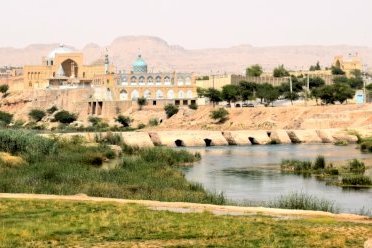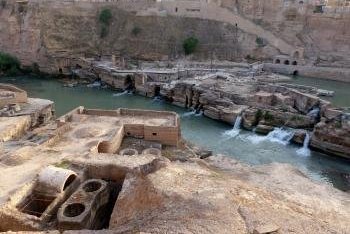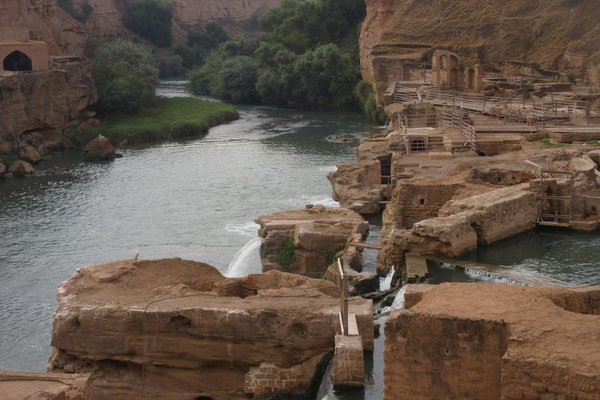Iran
Shushtar
The Shushtar Historical Hydraulic System comprises a complex irrigation system from the Sassanian era.
The system dates from the 3rd century and consists of the diversion of rivers into canals and large weir dams for land development. The water was both for agricultural irrigation and domestic use, it was distributed via a network of underground channels (qanats).
Community Perspective: There are 13 named points of interest here within one core zone. Only the “Waterfalls and Mills area” requires an entrance fee, which is also the most recommended to visit.
Site Info
Official Information
- Full Name
- Shushtar, Historical Hydraulic System (ID: 1315)
- Country
- Iran
- Status
-
Inscribed 2009
Site history
History of Shushtar
- 2009: Inscribed
- Inscribed
- Type
- Cultural
- Criteria
- i
- ii
- v
Links
- UNESCO
- whc.unesco.org
- Official
-
- visitiran.ir — Visit Iran
All Links
UNESCO.org
- whc.unesco.org — whc.unesco.org/
Official Website
- visitiran.ir — Visit Iran
News Article
- Nov. 15, 2021 tehrantimes.com — Shushtar Historical Hydraulic System closed amid safety concerns
- April 26, 2011 tehrantimes.com — UNESCO has demanded that Iran explain the situation following the collapse of a portion of the Gargar Bridge at the Shushtar's ancient water system
Community Information
- Community Category
- Secular structure: Civic and Public Works
Travel Information
Red Zone Travel Advisory
Iran fully off-limits
Shush Hotspot
Recent Connections
-
Linear inscriptions
Core zone follows the river and canals
-
Water Mills
"The site of fourteen mills and waterfa…
-
Red Zone Travel Advisory
Iran fully off-limits
Connections of Shushtar
- Individual People
-
-
Ibn Battuta
"I came next to the city of Tustar [Shushtar], which is situated at the edge of the plain in the dominion of the Atabek and the beginning of the mountains... It is encircled by the river called al-Azraq, which is a marvel... On both banks of the river, there are orchards and waterwheels..."
-
- Geography
-
-
Linear inscriptions
Core zone follows the river and canals
-
- History
-
-
Silk Roads
(Near) Classic Land Route; in ICOMOS thematic study but no details on role or function -
Sassanid Empire
-
- World Heritage Process
-
-
Perfect Inscriptions
2009
-
- Human Activity
- Constructions
-
-
Water Mills
"The site of fourteen mills and waterfalls downstream from the tunnels bored into the cliff, the outfall basin between the cliffs; some mills using traditional equipment are still in operation" (ICOMOS eval). There is a mixture of Vertical and Horizontal wheels.
-
Hydro Power Stations
"The mill site downstream from the dam underwent significant alteration 64 by local industry in the 20th century – a hydroelectric power plant and a pumping station in particular. Built on the rock, these buildings lower the authenticity of the hydraulic landscape but without altering it irreversibly and remain compatible with its prime functions." (AB eval). A notice board inside the site with a UNESCO logo states "The electricity supply station of Mostofizadeh. Built in the 1940s this power station has been supplied electricity of urban area before construction of the Dez dam" (sic) -
Notable Bridges
Caesar's bridge, Bridge of Valerian or Shadirwan: an ancient arch bridge, the first in the country to combine it with a dam; built by a Roman workforce in the 3rd century AD on Sassanid order, it was also the most eastern Roman bridgeSee en.wikipedia.org
-
Canals
-
- WHS on Other Lists
-
-
Globally Important Agricultural Heritage Systems (GIAHS)
Qanat Irrigation Systems and Homegardens Iran (candidate)See www.fao.org
-
- Timeline
-
-
Built in the 3rd century
in its present form, it dates from the 3rd century CE (AB ev)
-
- WHS Hotspots
-
-
Shush Hotspot
80km
-
- Visiting conditions
-
-
Red Zone Travel Advisory
Iran fully off-limits
-
News
- tehrantimes.com 11/15/2021
- Shushtar Historical Hydraulic Syst…
- tehrantimes.com 04/26/2011
- UNESCO has demanded that Iran expl…
Recent Visitors
Visitors of Shushtar
- Afshin Iranpour
- Alexander Barabanov
- Alexander Parsons
- Ammon Watkins
- Ask Gudmundsen
- Atila Ege
- Bernard Joseph Esposo Guerrero
- David Marton
- Erik Jelinek
- Fan Yibo
- fedemarch92
- George Gdanski
- Harry Mitsidis
- Ivan Rucek
- Jean Lecaillon
- Joyce van Soest
- Loic Pedras
- Maciej Gil
- Martin
- Martina Rúčková
- MaYumin
- Miloš Tašković
- Nihal Ege
- Roman Bruehwiler
- Solivagant
- Stanislaw Warwas
- Szucs Tamas
- Taotao Chen
- Thomas Buechler
- Vsacan
- Wojciech Fedoruk
- Zoë Sheng
Community Reviews
Show full reviews
After the rather lifeless sites of Susa and Tchogah Zanbil which we explored under the scorching summer heat of 2017, Shushtar's watermills and waterfalls delivered a most refreshing sight. No other visitors while we were there, so we enjoyed it very much. Water pressure was not at its best, but it was still okay. The presence of some waterfowls was also a delight especially for bird lovers like us. Two adjacent components of this WHS are the Gargar canal and Gargar bridge-dam. A section of the Karun river -- believed to be one of the four rivers of the Garden of Eden -- is part of the inscribed area and it is lined by the Band-e Mizan (in photo), Farangi tower, and Salasel castle. The river is eventually crossed by the ruins of impressively long Band-e Kaiser to the west (another interesting ancient Roman bridge in the region is Dezful bridge, the oldest functioning bridge in the world). I explored Salasel castle on my own and I was surprised to see that no one was manning the ruins at all, considering that it is the "most important" component of the entire water management system. Salasel hardly looks like a castle now, but the promontory offers great views of the river. Taking the advice of the previous review, we no longer took the effort in seeing the other components.
Iran is far from being short of exemplary sites displaying mastery of water use and water control. It also has …
Keep reading 0 comments
Despite reading the documents for this WHS prior to our visit in Apr 2016 I still didn’t feel that I had gained a good understanding of what it really was – and those pictures of a ruined bridge with a river or of some waterfalls, together with Wiki’s description of Shushtar as “an Island city”, didn’t exactly help. Having now been there, however, I find the UNESCO short description “spot on”. But how to bridge the gap for someone who hasn’t been there?
The description of the site as being a “Hydraulic System” perhaps needs some explanation. The UNESCO map lists 13 elements (and the locally available tourist map pushes this up to 26!). In its broadest sense, the totality (which spreads far beyond the inscribed 240 ha) indeed constitutes a “system” of man made structures started under the Achaemenids, c2500 years ago, and developed most significantly under the Sassanids (c300AD), for managing the waters of the River Karun (which Wiki states to be “Iran’s most effluent river”) around the town of Shushtar for a range of purposes – particularly agriculture and milling. These structures include dams, bridges, canals, mills etc. It developed across many centuries and, in fact, the most recent inscribed element is a hydraulic power station and ice factory dating from “1323 Solar Hejira” (1905??)!! And what of the “island city”? It is true that the canals do indeed create an “island” on which old Shushtar sits, before they rejoin the Karun, but this isn’t really a …
Keep reading 0 comments
